Alternative Use of Artificial Quarry Lakes as a Source of Thermal Energy for Greenhouses
Abstract
:1. Introduction
2. Materials and Methods
2.1. The Concept: Exploiting the Quarry Lake as a Heat Source
2.2. The “Provana” Quarry Site: Geographical and Geological Setting
- an Alluvial Complex, consisting of unconsolidated deposits, which can be assigned to quaternary fluvial deposits with gravelly–sandy texture and silt–clay intercalation hosting shallow groundwater;
- a “Villafranchiano” complex, with fluvio-lacustrine deposits of the late Pliocene to early Pleistocene;
- a deeper Marine complex, deposits of the early Pliocene marked by sand deposits.
2.3. Temperature Monitoring System
2.4. Evaluation of Heat Extraction Potential
3. Results
3.1. Temperature Monitoring
- from November to March, the lake below five meters’ depth had a rather homogeneous temperature, gradually decreasing from 14 to 7 °C (reached at the end of wintertime), usually higher than the air;
- from March to November, stratification occurred and the temperatures in the upper five meters of the lake exceeded 25 °C, whereas they remained 14–16 °C below 10 m depth.
3.2. Thermal Energy Potential of the Quarry Lake
4. Discussions and Conclusions
- (1)
- what are the environmental procedures to be followed?
- (2)
- can quarry lakes be used to obtain low-cost thermal energy, especially for agricultural needs (i.e., greenhouses or agribusiness factories)?
- (3)
- is this process sustainable and are there additional benefits?
Author Contributions
Funding
Institutional Review Board Statement
Informed Consent Statement
Data Availability Statement
Acknowledgments
Conflicts of Interest
References
- Castagna, S.; Dino, G.A.; Lasagna, M.; de Luca, D.A. Environmental Issues Connected to the Quarry Lakes and Chance to Reuse Fine Materials Deriving from Aggregate Treatments. In Engineering Geology for Society and Territory—Volume 5; Lollino, G., Manconi, A., Guzzetti, F., Culshaw, M., Bobrowsky, P., Luino, F., Eds.; Springer International Publishing: Cham, Switzerland, 2015; pp. 71–74. [Google Scholar]
- Jawecki, B.; Dąbek, P.B.; Pawęska, K.; Wei, X. Estimating Water Retention in Post-Mining Excavations Using LiDAR ALS Data for the Strzelin Quarry, in Lower Silesia. Mine Water Environ. 2018, 37, 744–753. [Google Scholar] [CrossRef] [Green Version]
- Molenda, T.; Ciupa, T.; Suligowski, R. The Properties of Reservoir Water in Post-Mining Excavations of Cambrian and Devonian Quartzite Sandstones (Holy Cross Mountains). Env. Earth Sci. 2020, 79, 310. [Google Scholar] [CrossRef]
- Kivinen, S. Sustainable Post-Mining Land Use: Are Closed Metal Mines Abandoned or Re-Used Space? Sustainability 2017, 9, 1705. [Google Scholar] [CrossRef] [Green Version]
- Peralta Ramos, E.; Breede, K.; Falcone, G. Geothermal Heat Recovery from Abandoned Mines: A Systematic Review of Projects Implemented Worldwide and a Methodology for Screening New Projects. Environ. Earth Sci. 2015, 73, 6783–6795. [Google Scholar] [CrossRef]
- Jessop, A. Geothermal Energy from Old Mines at Springhill, Nova Scotia, Canada; World geothermal Congress: Florence, Italy, 1995. [Google Scholar]
- Raymond, J.; Therrien, R. Low-Temperature Geothermal Potential of the Flooded Gaspé Mines, Québec, Canada. Geothermics 2008, 37, 189–210. [Google Scholar] [CrossRef]
- Hall, A.; Scott, J.A.; Shang, H. Geothermal Energy Recovery from Underground Mines. Renew. Sustain. Energy Rev. 2011, 15, 916–924. [Google Scholar] [CrossRef]
- Raymond, J.; Therrien, R. Optimizing the Design of a Geothermal District Heating and Cooling System Located at a Flooded Mine in Canada. Hydrogeol. J. 2014, 22, 217–231. [Google Scholar] [CrossRef]
- Casasso, A.; Tosco, T.; Bianco, C.; Bucci, A.; Sethi, R. How Can We Make Pump and Treat Systems More Energetically Sustainable? Water 2019, 12, 67. [Google Scholar] [CrossRef] [Green Version]
- Loredo, C.; Roqueñí, N.; Ordóñez, A. Modelling Flow and Heat Transfer in Flooded Mines for Geothermal Energy Use: A Review. Int. J. Coal Geol. 2016, 164, 115–122. [Google Scholar] [CrossRef]
- Al-Habaibeh, A.; Athresh, A.P.; Parker, K. Performance Analysis of Using Mine Water from an Abandoned Coal Mine for Heating of Buildings Using an Open Loop Based Single Shaft GSHP System. Appl. Energy 2018, 211, 393–402. [Google Scholar] [CrossRef] [Green Version]
- Comeau, F.-A.; Raymond, J.; Ngoyo Mandemyo, D. Évaluation Du Potentiel Géothermique Des Mines Désaffectées de Société Asbestos Limitée à Thetford Mines (Evaluation of Geothermal Potential of Former Asbestos Mines in Thetford Mines); INRS: Quebec City, QC, Canada, 2019. [Google Scholar]
- Giordano, N.; Canalis, L.; Ceppa, L.; Comina, C.; Degiorgis, L.; Giuliani, A.; Mandrone, G.; Marcon, G. How open-loop heat pumps on lakes can help environmental control: An example of geothermal circular economy. In Proceedings of the European Geothermal Congress, Strasbourg, France, 19–24 September 2016; pp. 1–9. [Google Scholar]
- Banks, D. Thermogeological Assessment of Open-Loop Well-Doublet Schemes: A Review and Synthesis of Analytical Approaches. Hydrogeol. J. 2009, 17, 1149–1155. [Google Scholar] [CrossRef]
- Preene, M.; Younger, P.L. Can You Take the Heat?—Geothermal Energy in Mining. Min. Technol. 2014, 123, 107–118. [Google Scholar] [CrossRef] [Green Version]
- Self, S.J.; Reddy, B.V.; Rosen, M.A. Geothermal Heat Pump Systems: Status Review and Comparison with Other Heating Options. Appl. Energy 2013, 101, 341–348. [Google Scholar] [CrossRef]
- Bertoldi, P.; Avgerinou, M.; Castellazzi, L. Trends in Data Centre Energy Consumption under the European Code of Conduct for Data Centre Energy Efficiency; EUR 28874 EN; Publications Office of the European Union: Luxembourg, Luxembourg, 2017; JRC108354. [Google Scholar] [CrossRef]
- IRENA, IEA, REN21. Renewable Energy Policies in a Time of Transition: Heating and Cooling. IRENA, OECD/IEA and REN21, 2020. Available online: https://www.irena.org/publications/2020/Nov/Renewable-energy-policies-in-a-time-of-transition-Heating-and-cooling (accessed on 13 November 2021).
- Koronen, C.; Åhman, M.; Nilsson, L.J. Data centres in future European energy systems—Energy efficiency, integration and policy. Energy Effic. 2020, 13, 129–144. [Google Scholar] [CrossRef] [Green Version]
- Biella, G.; Polino, R.; de Franco, R.; Rossi, P.M.; Clari, P.; Corsi, A.; Gelati, R. The crustal structure of the western Po plain: Reconstruction from integrated geological and seismic data. Terra Nova 1997, 9, 28–31. [Google Scholar] [CrossRef]
- Piana, F.; Fioraso, G.; Irace, A.; Mosca, P.; D’Atri, A.; Barale, L.; Falletti, P.; Monegato, G.; Morelli, M.; Tallone, S.; et al. Geology of Piemonte region (NW Italy, Alps–Apennines interference zone). J. Maps 2017, 13, 395–405. [Google Scholar] [CrossRef]
- Mas-Pla, J.; Menció, A. Groundwater nitrate pollution and climate change: Learnings from a water balance-based analysis of several aquifers in a western Mediterranean region (Catalonia). Environ. Sci. Pollut. Res. 2019, 26, 2184–2202. [Google Scholar] [CrossRef] [PubMed] [Green Version]
- Visser, A.-N.; Lehmann, M.F.; Rügner, H.; D’Affonseca, F.M.; Grathwohl, P.; Blackwell, N.; Kappler, A.; Osenbrück, K. Fate of nitrate during groundwater recharge in a fractured karst aquifer in Southwest Germany. Hydrogeol. J. 2021, 29, 1153–1171. [Google Scholar] [CrossRef]
- CSI Piemonte. Geopiemonte. Ambiente Energia, Territorio, Regione Piemonte. Available online: http://www.geoportale.piemonte.it/geocatalogorp/?sezione=mappa (accessed on 22 April 2021).
- Raymond, J. Colloquium 2016: Assessment of subsurface thermal conductivity for geothermal applications. Can. Geothech. J. 2018, 55, 1209–1229. [Google Scholar] [CrossRef] [Green Version]
- Pelletier, F.; Godbout, S. Consommation d’énergie et émissions de gaz à effet de serre en production serricole au Québec. Institut de Recherche et de Développement en Agroenvironnement. Québec, Projet IRDA 400023. 2017, p. 36. Available online: https://www.serres.quebec/consommation-energetique-et-emissions-de-ges/ (accessed on 13 November 2021).
- Maddah, S.; Goodarzi, M.; Safaei, M.R. Comparative study of the performance of air and geothermal sources of heat pumps cycle operating with various refrigerants and vapor injection. Alex. Engin. J. 2020, 59, 4037–4047. [Google Scholar] [CrossRef]
- Johnson, R.K. Measured Performance of a Low Temperature Air Source Heat Pump; US Department of Energy, Building Technologies Offices: Washington, DC, USA, 2013. [Google Scholar]
- Lei, F.; Hu, P. A comparative study on long-term energy efficiency of two kinds of ground-source heat pump systems. Adv. Mat. Res. 2014, 1070–1072, 349–352. [Google Scholar] [CrossRef]
- Giordano, N.; Riggi, L.; Della Valentina, S.; Casasso, A.; Mandrone, G.; Raymond, J. Efficiency evaluation of borehole heat exchangers in Nunavik, Québec, Canada. In Proceedings of the 25th IIR International Congress of Refrigeration, Montreal, QC, Canada, 24–30 September 2019; pp. 4381–4388. [Google Scholar] [CrossRef]
- Sarbu, I.; Sebachievici, C. Using Ground-Source Heat Pump Systems for Heating/Cooling of Buildings. In Advances in Geothermal Energy; Ismail, B., Ed.; IntechOpen: London, UK, 2015. [Google Scholar] [CrossRef] [Green Version]
- Seelen, L.M.S.; Teurlincx, S.; Bruinsma, J.; Huijsmans, T.M.F.; van Donk, E.; Lurling, M.; de Senerpont Domis, L.N. The value of novel cosystems: Disclosing the ecological quality of quarry lakes. Sci. Total. Environ. 2020, 769, 1–11. [Google Scholar]
- Sahoo, G.B.; Schladow, S.G.; Reuter, J.E.; Coats, R. Effects of climate change on thermal properties of lakes and reservoirs, and possible implications. Stoch. Environ. Res. Risk Assess. 2011, 25, 445–456. [Google Scholar] [CrossRef] [Green Version]
- Prats, J.; Roubeix, V.; Reynaud, N.; Tormos, T.; Danis, P.A. The thermal behaviour of French water bodies: From ponds to Lake Geneva. J. Great Lakes Res. 2020, 46, 718–731. [Google Scholar] [CrossRef]
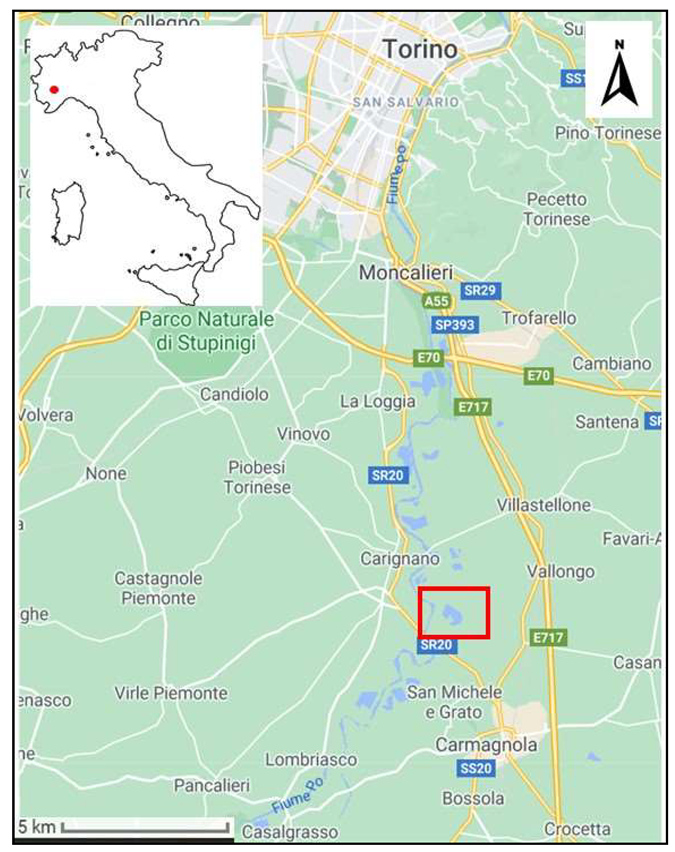
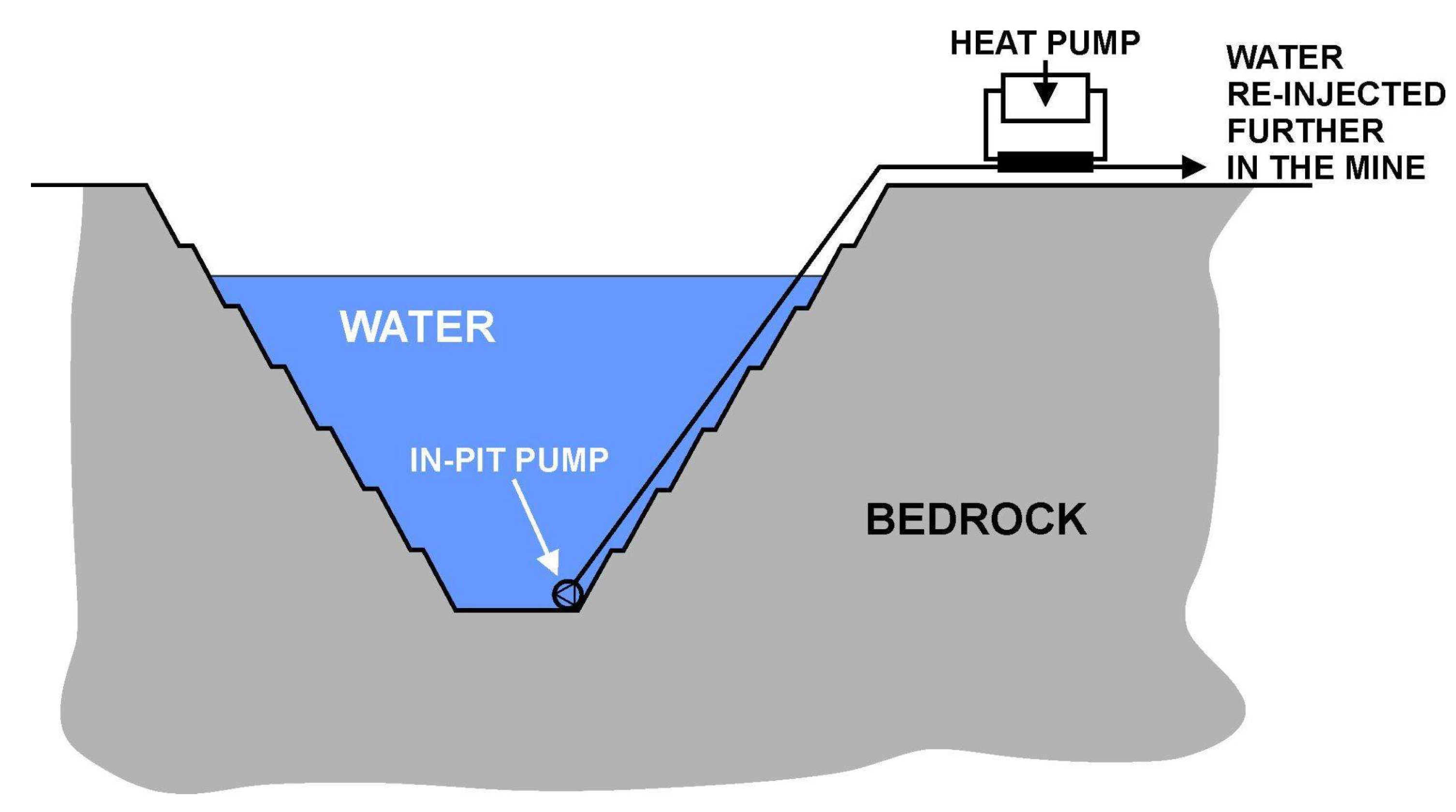
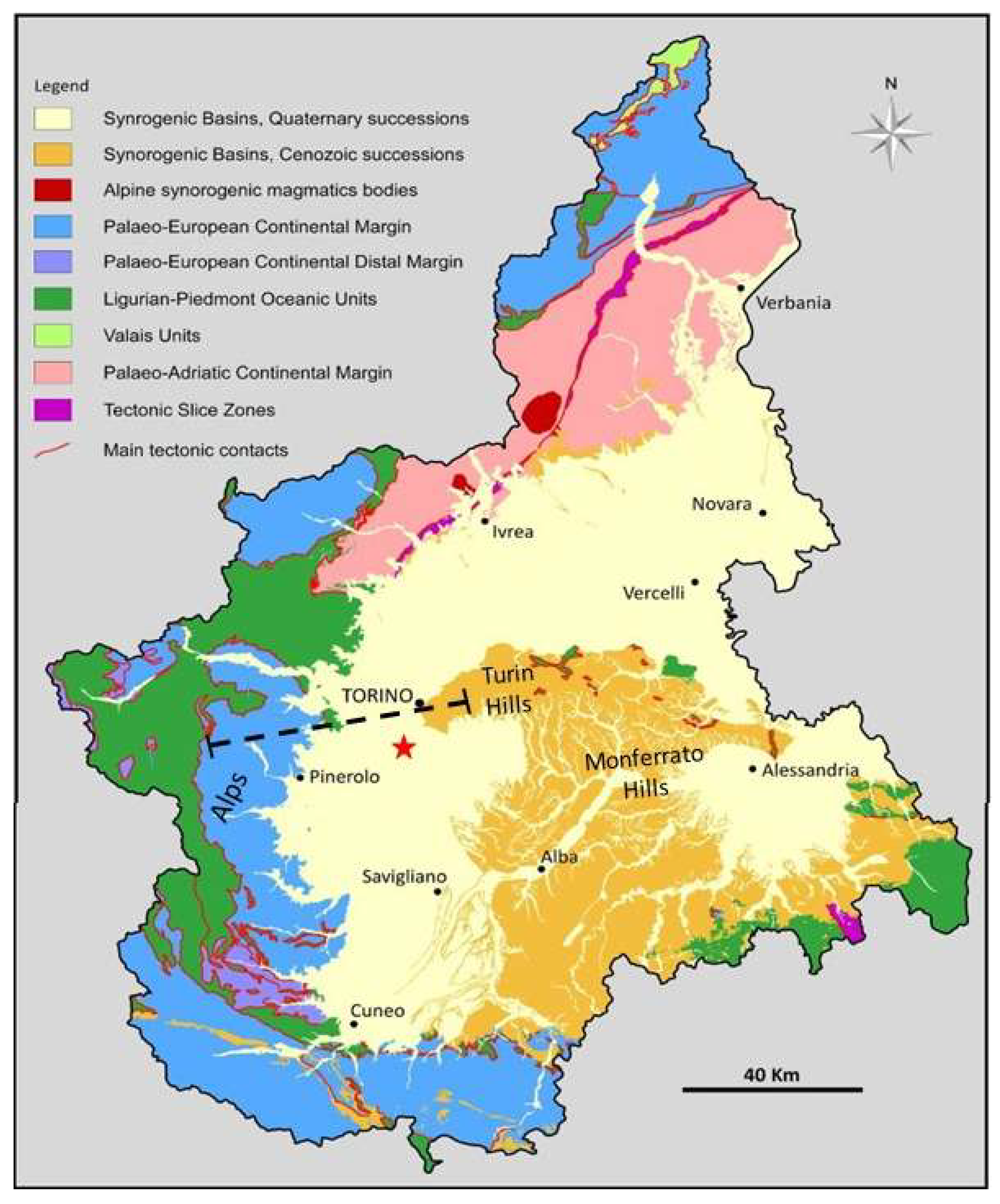
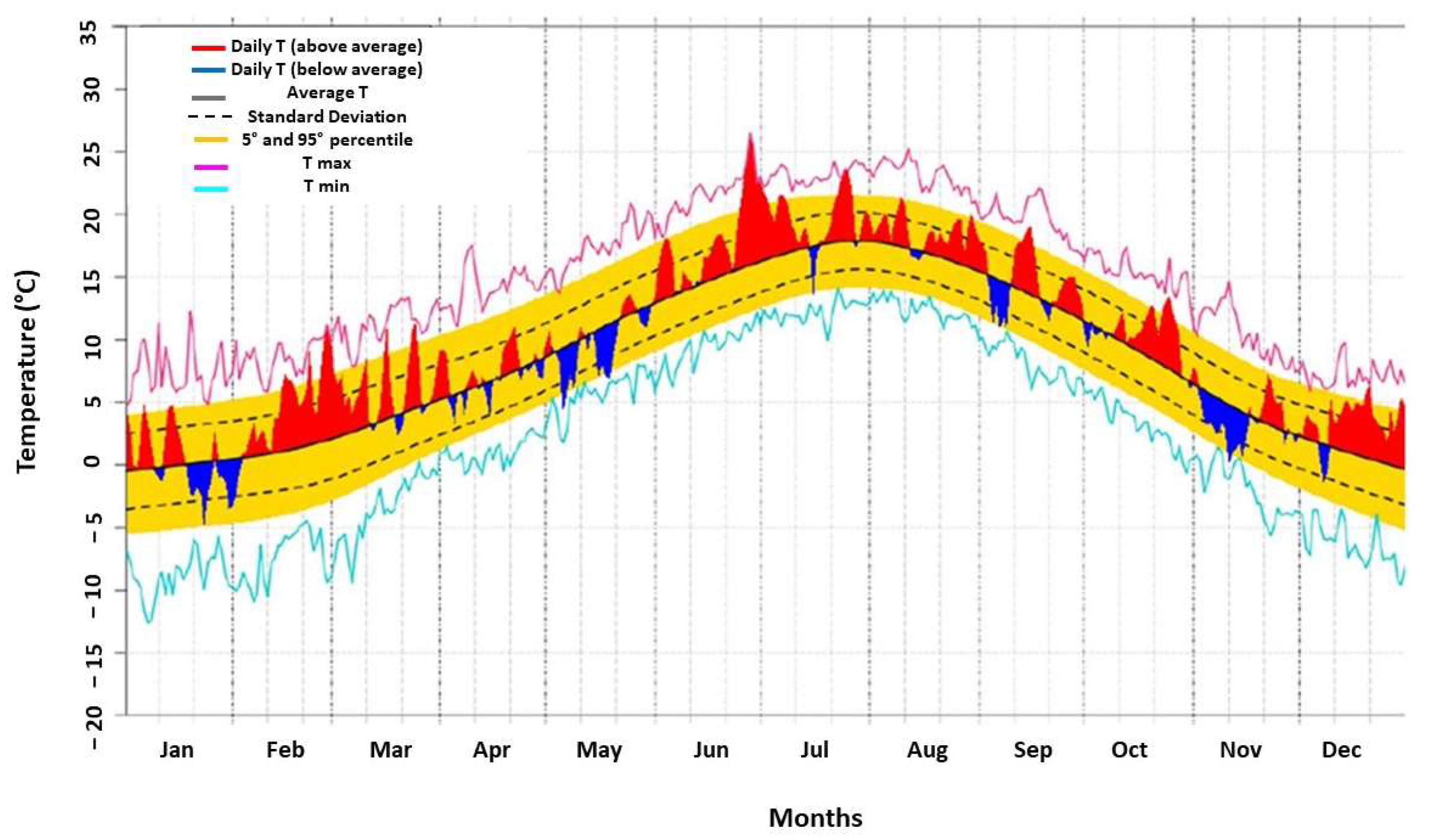
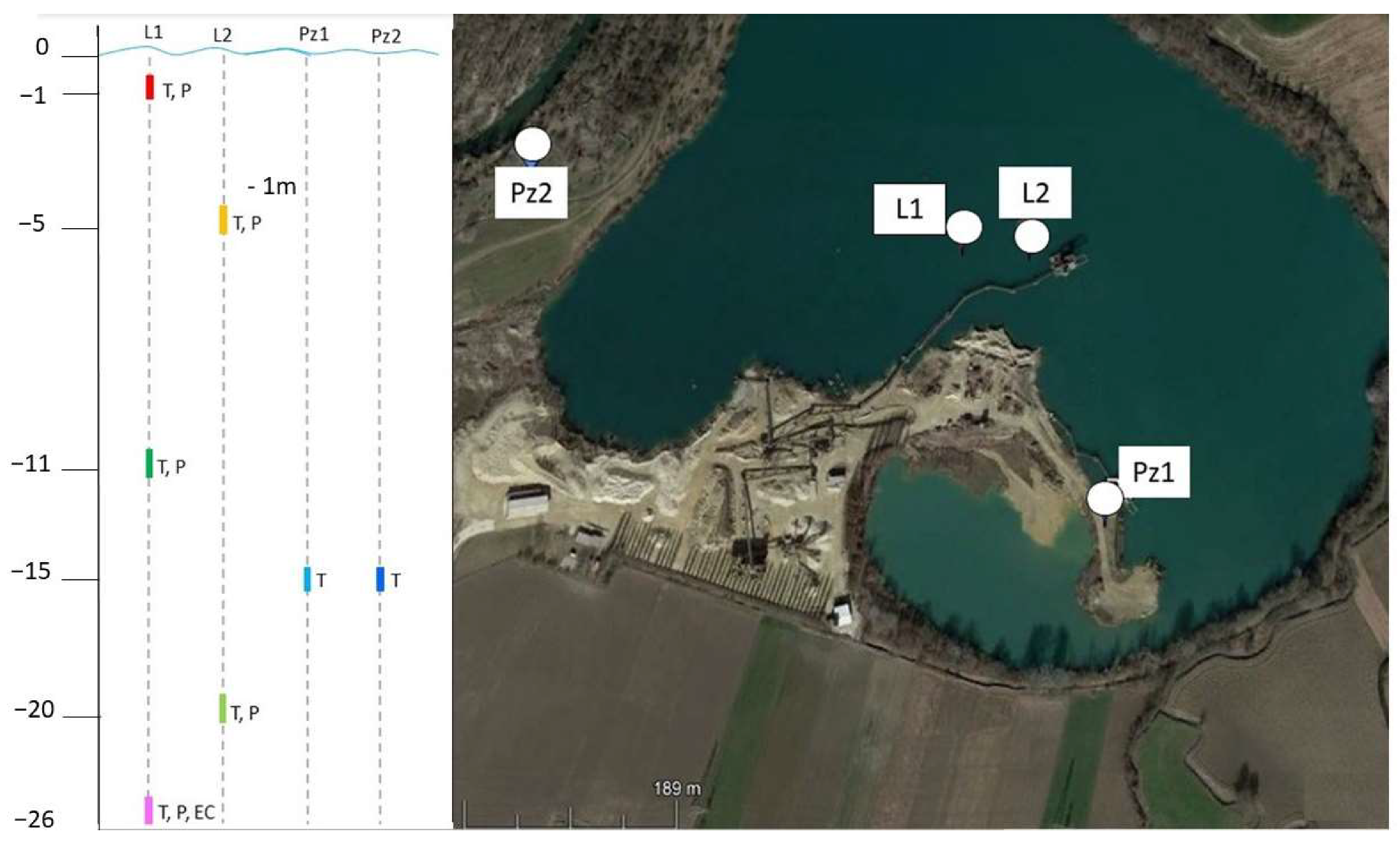
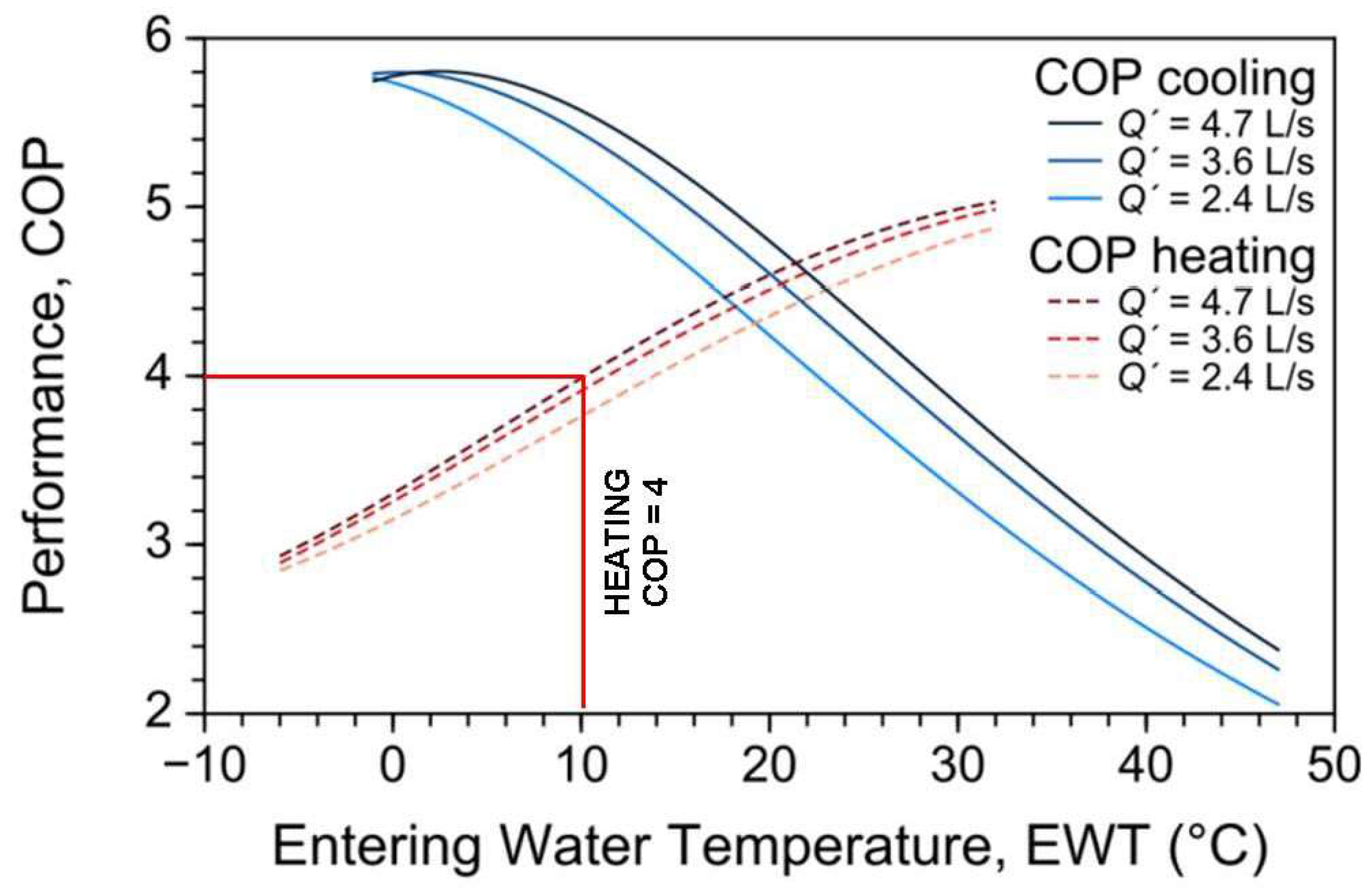
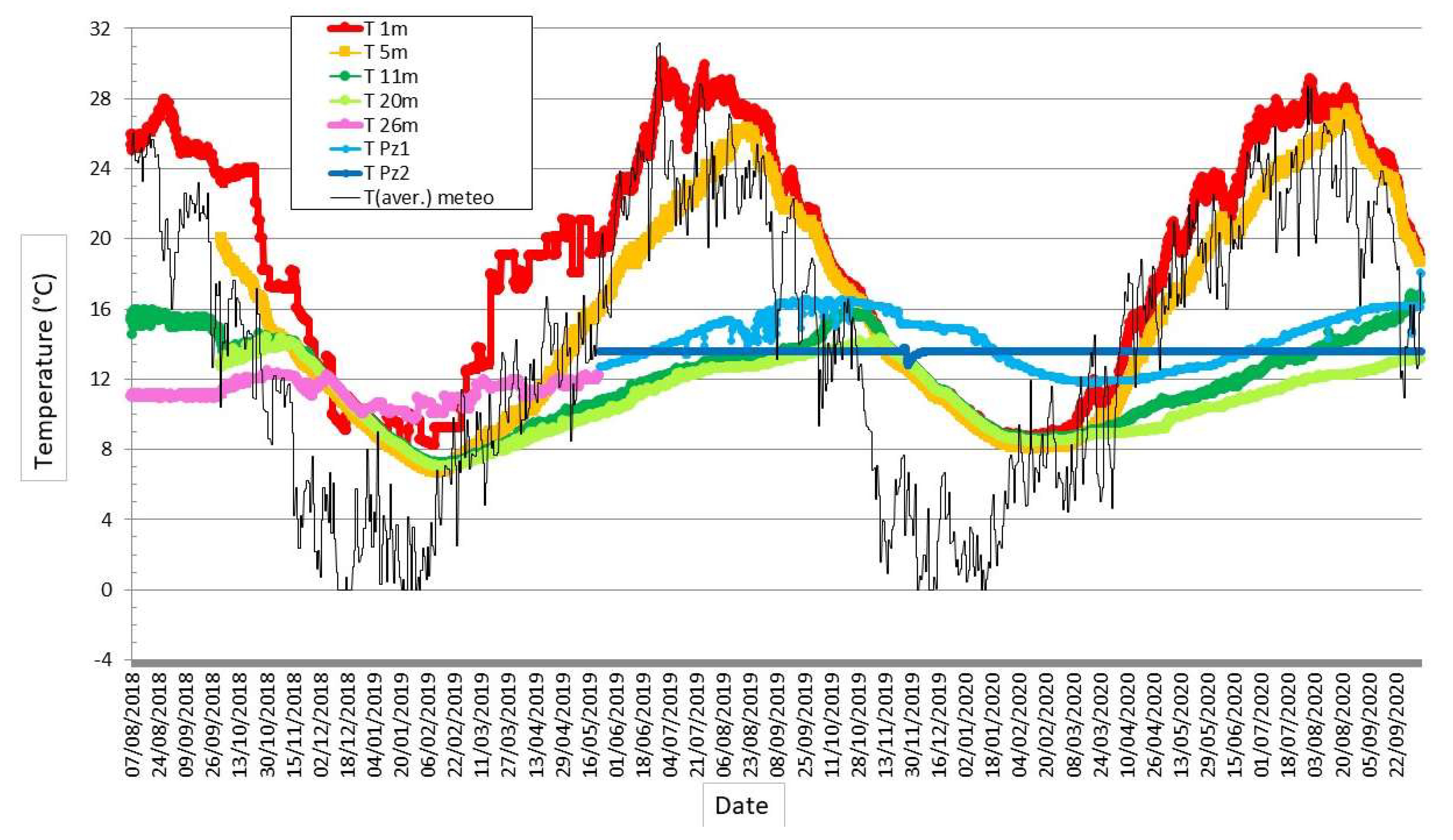
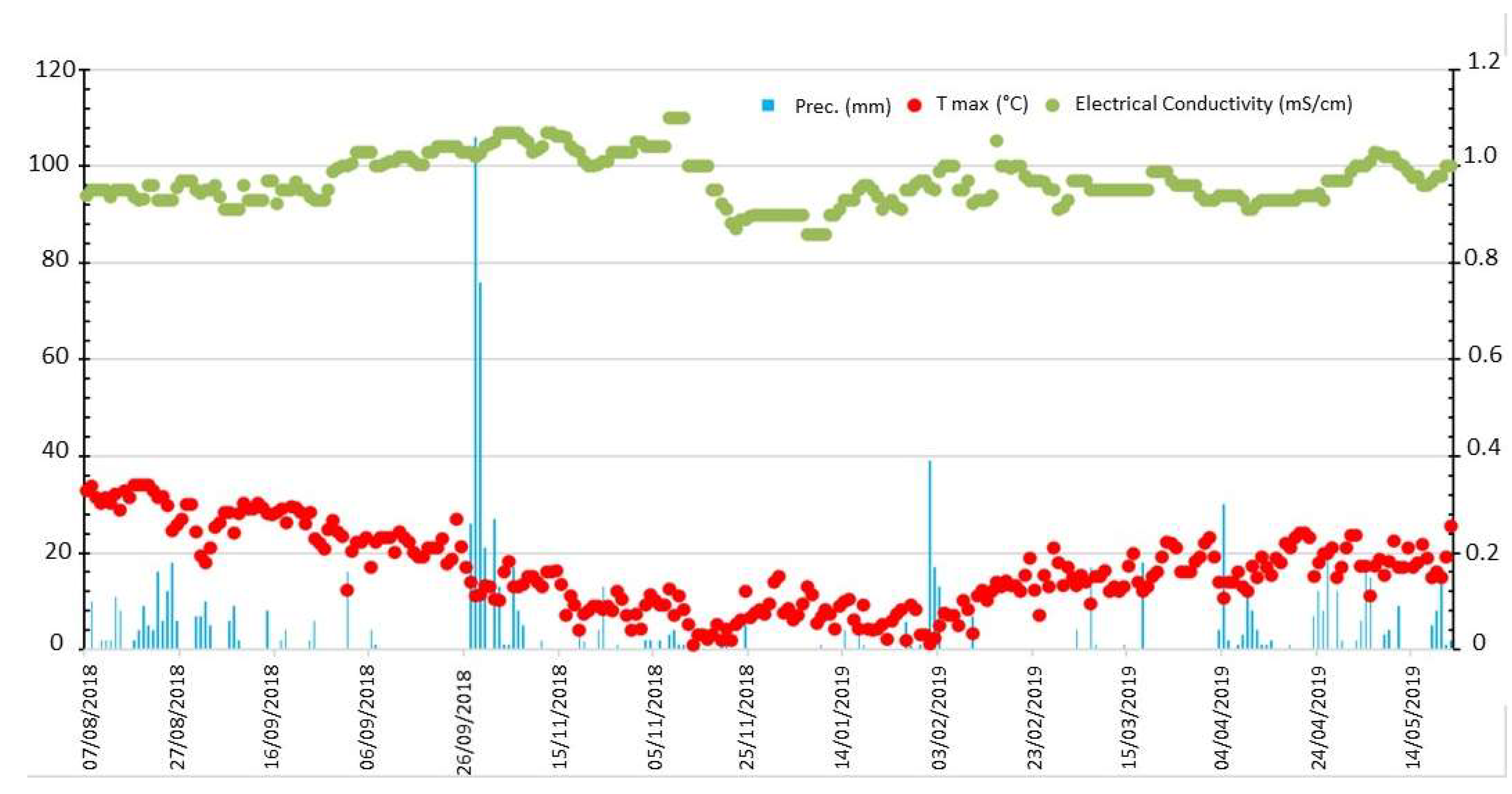
| Depth (m) | Device | ID | Recording Time (h) | Temperature Accuracy (°C) | Pressure Accuracy (mmH2O) |
|---|---|---|---|---|---|
| −1 | Mini Diver (Van Essen Instruments, Tucker, GA, USA) | L1 | 6 | 0.1 | 2.5 |
| −5 | Levelogger Edge (Solinst Canada LTD, Ontario, Canada) | L2 | 1 | 0.05 | 1.5 |
| −11 | Mini Diver (Van Essen Instruments, Tucker, GA, USA) | L1 | 6 | 0.1 | 2.5 |
| −15 | Microtemp (Madgetech Inc., Warner NH USA) | Pz1 | 1 | 0.5 | / |
| −15 | Microtemp Madgetech (Madgetech Inc., Warner NH USA) | Pz2 | 1 | 0.5 | / |
| −20 | Levelogger Edge Solinst (Canada LTD, Georgetown, Ontario, Canada) | L2 | 1 | 0.05 | 1.5 |
| −26 | CTD Diver (Van Essen Instruments, Tucker GA USA) | L1 | 6 | 0.1 | 2.5 |
| Depth Slices | Area (m2) | Volume (m3) |
|---|---|---|
| 0–5 m | 325,000 | 1,625,000 |
| 5–10 m | 281,718 | 1,408,591 |
| 10–15 m | 241,528 | 1,207,640 |
| 15–20 m | 204,429 | 1,022,146 |
| 20–25 m | 170,422 | 852,111 |
| 25–30 m | 139,507 | 697,533 |
| 6,813,020 |
| JAN | FEB | MAR | APR | MAY | JUN | JUL | AUG | SEP | OCT | NOV | DEC | |
|---|---|---|---|---|---|---|---|---|---|---|---|---|
| HHD (<18 °C) | 884 | 766 | 641 | 363 | 156 | 38 | 9 | 23 | 117 | 305 | 501 | 768 |
| Energy needs (kWh m−2) | 135 | 117 | 98 | 56 | 24 | 6 | 1 | 4 | 18 | 47 | 77 | 118 |
| kg CO2e from oil [m−2] | 37 | 32 | 27 | 15 | 7 | 2 | 0 | 1 | 5 | 13 | 21 | 32 |
| kg CO2e from natural gas [m−2] | 24 | 21 | 18 | 10 | 4 | 1 | 0 | 1 | 3 | 8 | 14 | 21 |
| kg CO2e from propane [m−2] | 30 | 26 | 21 | 12 | 5 | 1 | 0 | 1 | 4 | 10 | 17 | 26 |
| m | JAN | FEB | MAR | APR | MAY | JUN | JUL | AUG | SEP | OCT | NOV | DEC | AVERAGE | |
|---|---|---|---|---|---|---|---|---|---|---|---|---|---|---|
| YEAR | NOV to APR | |||||||||||||
| air | 2.6 | 6.3 | 8.9 | 13.8 | 16.6 | 22.6 | 23.8 | 23.6 | 19.3 | 13.9 | 6.7 | 2.3 | 13.4 | 6.8 |
| Pz1 | 13.9 | 12.4 | 11.9 | 12.0 | 12.7 | 13.3 | 14.4 | 15.2 | 16.1 | 16.3 | 15.9 | 15.0 | 14.1 | 13.5 |
| Pz2 | 13.6 | 13.6 | 13.6 | 13.6 | 13.6 | 13.6 | 13.6 | 13.6 | 13.6 | 13.6 | 13.5 | 13.6 | 13.6 | 13.6 |
| 0–5 | 8.9 | 8.2 | 10.8 | 14.3 | 18.3 | 22.0 | 25.4 | 26.4 | 23.4 | 21.5 | 15.7 | 11.0 | 17.2 | 11.5 |
| 5–10 | 8.7 | 7.7 | 8.6 | 10.9 | 13.9 | 16.5 | 18.8 | 20.9 | 19.4 | 19.2 | 15.3 | 11.0 | 14.3 | 10.4 |
| 10–15 | 8.9 | 7.9 | 8.4 | 9.6 | 10.9 | 12.2 | 13.4 | 14.8 | 14.9 | 15.0 | 14.1 | 11.3 | 11.8 | 10.0 |
| 15–20 | 8.9 | 7.8 | 8.2 | 9.1 | 10.1 | 11.0 | 12.1 | 12.9 | 13.4 | 13.9 | 13.8 | 11.2 | 11.0 | 9.8 |
| 20–25 | 9.4 | 8.9 | 9.5 | 9.9 | 10.7 | 11.1 | 11.6 | 11.8 | 12.1 | 12.9 | 12.9 | 11.1 | 11.0 | 10.3 |
| 25–30 | 10.2 | 10.5 | 11.4 | 11.4 | 11.9 | 11.6 | 11.3 | 11.0 | 11.0 | 11.8 | 11.9 | 11.1 | 11.3 | 11.1 |
| E (MWh) | ||||||||||||
|---|---|---|---|---|---|---|---|---|---|---|---|---|
| m | JAN | FEB | MAR | APR | MAY | JUN | JUL | AUG | SEP | OCT | NOV | DEC |
| 0–5 | −15,624 | −16,930 | −12,080 | −5471 | 2139 | 9218 | 15,471 | 17,540 | 11,877 | 8284 | −2704 | −11,721 |
| 5–10 | −9108 | −10,699 | −9207 | −5511 | −523 | 3711 | 7446 | 10,882 | 8406 | 8152 | 1721 | −5270 |
| 10–15 | −4019 | −5472 | −4756 | −3042 | −1205 | 523 | 2290 | 4166 | 4440 | 4532 | 3258 | −714 |
| 15–20 | −2532 | −3796 | −3309 | −2317 | −1167 | −11 | 1242 | 2219 | 2812 | 3394 | 3260 | 205 |
| 20–25 | −1580 | −2050 | −1475 | −1055 | −328 | 104 | 584 | 806 | 1110 | 1843 | 1916 | 123 |
| 25–30 | −877 | −579 | 106 | 131 | 493 | 261 | 28 | −204 | −188 | 434 | 506 | −111 |
| TOTAL | −33,740 | −39,526 | −30,721 | −17,266 | −590 | 13,807 | 27,062 | 35,409 | 28,457 | 26,638 | 7957 | −17,488 |
| JAN | FEB | MAR | APR | MAY | JUN | JUL | AUG | SEP | OCT | NOV | DEC | |
|---|---|---|---|---|---|---|---|---|---|---|---|---|
| HHD (<18 °C) | 482 | 363 | 270 | 159 | 104 | 0 | 0 | 0 | 23,9 | 130 | 372 | 481 |
| Energy needs (kWh m−2) | 74 | 55 | 41 | 25 | 16 | 0 | 0 | 0 | 4 | 20 | 57 | 74 |
| kg CO2e for oil [m−2] | 20 | 15 | 11 | 7 | 5 | 0 | 0 | 0 | 1 | 6 | 16 | 20 |
| kg CO2e natural gas [m−2] | 13 | 10 | 8 | 4 | 3 | 0 | 0 | 0 | 1 | 3 | 10 | 13 |
| kg CO2e propane [m−2] | 16 | 12 | 9 | 5 | 3 | 0 | 0 | 0 | 1 | 4 | 13 | 16 |
| Parameters | ΔT = 1 |
|---|---|
| Thermal power extracted from the lake (MW) | 1.808 |
| Pumping rate (m3 s−1) | 0.432 |
| Coefficient of performance (COP) | 4.00 |
| Compressor power (MW) | 0.603 |
| Pumping power (MW) | −0.042 |
| Total power provided by the heat pump (MW) | 2.410 |
| Efficiency ratio (%) | 73 |
| Total energy (MW h) | 10,558 |
| Energy for 1 m2 of greenhouse (MWh) | 0.326 |
| Heatable greenhouse area (m2) | 32,385 |
| CO2e emissions with oil (kg) | 2,879,770 |
Publisher’s Note: MDPI stays neutral with regard to jurisdictional claims in published maps and institutional affiliations. |
© 2021 by the authors. Licensee MDPI, Basel, Switzerland. This article is an open access article distributed under the terms and conditions of the Creative Commons Attribution (CC BY) license (https://creativecommons.org/licenses/by/4.0/).
Share and Cite
Chicco, J.M.; Comeau, F.-A.; Casasso, A.; Comina, C.; Giordano, N.; Mandrone, G.; Raymond, J. Alternative Use of Artificial Quarry Lakes as a Source of Thermal Energy for Greenhouses. Water 2021, 13, 3560. https://doi.org/10.3390/w13243560
Chicco JM, Comeau F-A, Casasso A, Comina C, Giordano N, Mandrone G, Raymond J. Alternative Use of Artificial Quarry Lakes as a Source of Thermal Energy for Greenhouses. Water. 2021; 13(24):3560. https://doi.org/10.3390/w13243560
Chicago/Turabian StyleChicco, Jessica Maria, Felix-Antoine Comeau, Alessandro Casasso, Cesare Comina, Nicolò Giordano, Giuseppe Mandrone, and Jasmin Raymond. 2021. "Alternative Use of Artificial Quarry Lakes as a Source of Thermal Energy for Greenhouses" Water 13, no. 24: 3560. https://doi.org/10.3390/w13243560
APA StyleChicco, J. M., Comeau, F.-A., Casasso, A., Comina, C., Giordano, N., Mandrone, G., & Raymond, J. (2021). Alternative Use of Artificial Quarry Lakes as a Source of Thermal Energy for Greenhouses. Water, 13(24), 3560. https://doi.org/10.3390/w13243560








